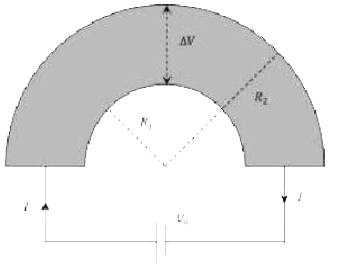Shown in the figure is a semi - circular metallic strip that has thickness t and resistivity ρ its inner radius is R1 and outer radius is R2. It a voltage V0 is applied between its two ends , a current I floes in it . In addition , it is observed that a transverse voltage ΔV develops between its inner and outer surfaces due to puerly kinetic effects of moving electrons (ignore any role of the magnetic field due to the current). Then (figure is schematic and not drawn to scale

1=V0tπρIn(R2R1)
the outer surface is at a higher voltage than inner surface
the outer surface is at a lower voltage than the inner surface
ΔV∝12
The correct Answer is:A, C, D

Resistance of the stop =ρπrldr
R=net resistance
1R=∫tdrfπr∫RR2drr1
R=πRt/n(R2R1)
hence current I=V0R=V0tlnR2R1πρ
for elementary dr
di=V0ρ(πrtdr)=V0tdrρπr
i=nAeV
V0tdrρπr=ntdreV
eE=mV2r=mV20n2t2ρ2π2r2α1r
mV2r=mV20n2t2ρ2r2∝1r
E∝1r3 E=k1r3
ΔV=∫Edr=k∫RR21drv2∝V20
Topper's Solved these Questions
- BOOK - JEE ADVANCED PREVIOUS YEARCHAPTER - JEE ADVANCED 2020EXERCISE - SECTION-36videos
JEE ADVANCED 2020
- BOOK - JEE ADVANCED PREVIOUS YEARCHAPTER - JEE ADVANCED 2020EXERCISE - SECTION-36videos
JEE ADVANCED 2020
- BOOK - JEE ADVANCED PREVIOUS YEARCHAPTER - JEE ADVANCEDEXERCISE - PHYSICS SECTION - IV Matrix Match Type2videos
JEE ADVANCED
- BOOK - JEE ADVANCED PREVIOUS YEARCHAPTER - JEE ADVANCED 2021EXERCISE - QUESTION38videos
JEE ADVANCED 2021
Similar Questions
Put a unifrom meter scale horizontally on your extended index fingers with the left one at 0.0 cm and the right one at 90.00 cm when you attempt to move both the fingers slowly towards the center , initially only the left finger slips with respect to to the scale and the right finger does not . after some distance, the left finger stops and the right one starts slipping . Then the right finger stops at a distance XR from the center (50.00 cm ) of the scale and the left one starts slopping again . This happens because to the difference in the fiictional forces on the two fingers . it the coefficients of static and dynamic between the fingers and the scale are 0.4 and 0.32 respectively , the value of XR (in cm is ...........
04:01View SolutionPut a unifrom meter scale horizontally on your extended index fingers with the left one at 0.0 cm and the right one at 90.00 cm when you attempt to move both the fingers slowly towards the center , initially only the left finger slips with respect to to the scale and the right finger does not . after some distance, the left finger stops and the right one starts slipping . Then the right finger stops at a distance XR from the center (50.00 cm ) of the scale and the left one starts slopping again . This happens because to the difference in the fiictional forces on the two fingers . it the coefficients of static and dynamic between the fingers and the scale are 0.4 and 0.32 respectively , the value of XR (in cm is ...........
02:22View SolutionOne mole of a monatomic ideal gas is taken through a cycle ABCDA as shown in the P-V diagram. Column II gives the characteristics involved in the cycle. Match them with each of the processes given in Column I.
 04:42View Solution
04:42View SolutionThe smallest division on the main scale of a vernier calipers is 0.1cm. Ten divisions of the vernier scale correspond to nine divisions of the main scale. The figure below on the left shows the reading of this calipers with no gap between in two jaws. The figure on the right shows the reading with a solid sphere held between the jaws. The correct diameter of the sphere is.
 03:27View Solution
03:27View SolutionSphere of inner radius a and outer radius b is made of p uniform resistivity find resistance between inner and outer surface
04:00View SolutionA metal spherical shell has an inner radius R1 and outer radius R2. A charge Q is placed at the center of the spherical cavity. What will be surface charge density on (i) the inner surface, and (ii) the outer surface ?
04:00View SolutionA hollow cylinder of specific resistance rho , inner radius R , outer radius 2R and length 1 is as shown in figure. What is the net resistance between the inner and outer surfaces?
02:35View SolutionSpace between tow concentric spheres of radii r1andr2 such that r1<r2 is filled with a material of resistivity ρ. Find the resistance between inner and outer surface of the material
 03:18View Solution
03:18View SolutionA cylindrical tube of length l has inner radius a while outer radius b. What is the resistance of the tube between (a) its ends (b) inner and outer surfaces ? (The resistivitiy of its material is p)
04:02View SolutionA cylindrical tube of length l has inner radius a while outer radius b. What is the resistance of the tube between (a) its ends (b) inner and outer surfaces ? (The resistivitiy of its material is p)
View SolutionA metal spherical shell has an inner radius R_(1) and outer radius R_(2) . A charge Q is placed at the center of the spherical cavity. What will be surface charge density on (i) the inner surface, and (ii) the outer surface ?
04:03View SolutionSphere of inner radius a and outer radius b is made of p uniform resistivity find resistance between inner and outer surface
02:58View SolutionSphere of inner radius a and outer radius b is made of p uniform resistivity find resistance between inner and outer surface
04:15View SolutionA thick spherical shell has inner radius a and outer b. The material has resistivity ρ . When a potential difference is applied between the inner and outer surfaces, its resistance is
03:51View SolutionA cylindrical tube of length L has inner radius a while outer b. What is the resistance of the tube between its inner and outer surfaces? [The resistivity of its material is ρ]
04:05View Solution

